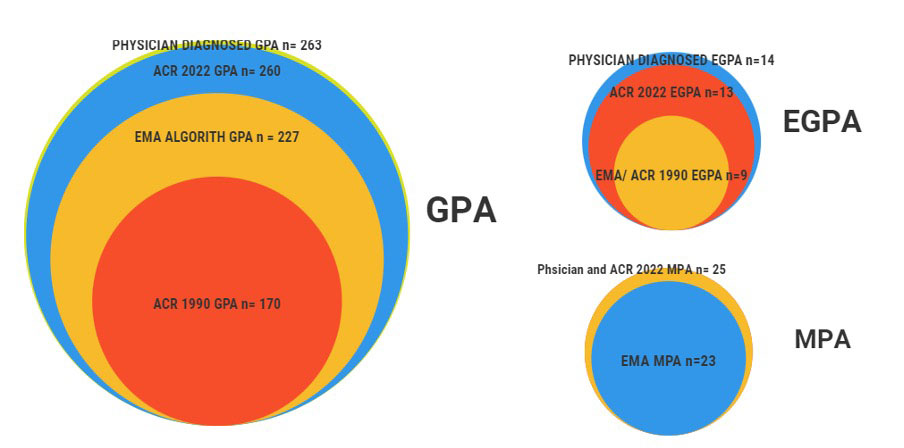Session Information
Date: Saturday, November 12, 2022
Title: Vasculitis – ANCA-Associated Poster I: Epidemiology, Outcomes, and Classification
Session Type: Poster Session A
Session Time: 1:00PM-3:00PM
Background/Purpose: The purpose of this study was to validate the recently published 2022 American College of Rheumatology/European Alliance of Associations for Rheumatology Classification Criteria for classification of ANCA associated vasculitis/AAV (Granulomatosis with Polyangiitis [GPA], Eosinophilic Granulomatosis with Polyangiitis [EGPA] and Microscopic Polyangiitis [MPA])
Methods: Patients with a diagnosis of AAV from Indian vasculitis registry (INVAR) cohort were included in the study. The new 2022 ACR classification criteria of AAV[1]–[3], 1990 ACR classification criteria for GPA and EGPA, and the EMA Algorithm were validated in our cohort to assess their performance. The level of agreement was assessed using Cohen’s kappa. The clinician’s diagnosis was considered as the gold standard.
Results: A total of 302 patients diagnosed AAV with mean age of 42.87 ± 14.7 years were included. 58.7% were females and 42.3 % were males. Table 1 and Figure 1 show the distribution of AAV patients classified according to various classification criteria. The new ACR 2022 criteria for GPA (kappa: 0.961; sensitivity: 99% and specificity: 99%), MPA (kappa: 0.992, sensitivity: 99.9% and specificity: 99.9%), EGPA (kappa:0.961, sensitivity: 92% and 100%) had almost perfect agreement with INVAR cohort. Table 2 shows performance of EMA algorithm and the ACR 1990 criteria compared to the new 2022 classification criteria for AAV in the INVAR cohort. Furthermore, predominant CNS or ocular GPA (if PR3/MPO negative) were missed by the new ACR classification criteria. EMA Algorithm missed cases of ANCA vasculitis where histology was not possible or ANCA was positive by IIF.
Conclusion: The study showed the new criteria for AAV, had good performance in INVAR registry AAV patients. The new criteria had good sensitivity and specificity for classification of GPA, MPA and EGPA compared to EMA algorithm.
References:
- Suppiah R, Robson JC, Grayson PC, Ponte C, Craven A, Khalid S, et al. 2022 American College of Rheumatology/European Alliance of Associations for Rheumatology Classification Criteria for Microscopic Polyangiitis. Arthritis Rheumatol. 2022;74(3):400–6.
- Robson JC, Grayson PC, Ponte C, Suppiah R, Craven A, Judge A, et al. 2022 American College of Rheumatology/European Alliance of Associations for Rheumatology Classification Criteria for Granulomatosis With Polyangiitis. Arthritis Rheumatol.2022;74(3):393–9.
- Grayson PC, Ponte C, Suppiah R, Robson JC, Craven A, Judge A, et al. 2022 American College of Rheumatology/European Alliance of Associations for Rheumatology Classification Criteria for Eosinophilic Granulomatosis With Polyangiitis. Arthritis Rheumatol. 2022;74(3):386–92.
To cite this abstract in AMA style:
Sharma A, Deo P, Naidu S, Samanta J, Mittal S, Sharma K, Nada R, Dhir V, jain s, Minz R. Validation of the 2022 – American College of Rheumatology/European Alliance of Associations for Rheumatology Classification Criteria in Patients with ANCA Associated Vasculitis [abstract]. Arthritis Rheumatol. 2022; 74 (suppl 9). https://acrabstracts.org/abstract/validation-of-the-2022-american-college-of-rheumatology-european-alliance-of-associations-for-rheumatology-classification-criteria-in-patients-with-anca-associated-vasculitis/. Accessed .« Back to ACR Convergence 2022
ACR Meeting Abstracts - https://acrabstracts.org/abstract/validation-of-the-2022-american-college-of-rheumatology-european-alliance-of-associations-for-rheumatology-classification-criteria-in-patients-with-anca-associated-vasculitis/



